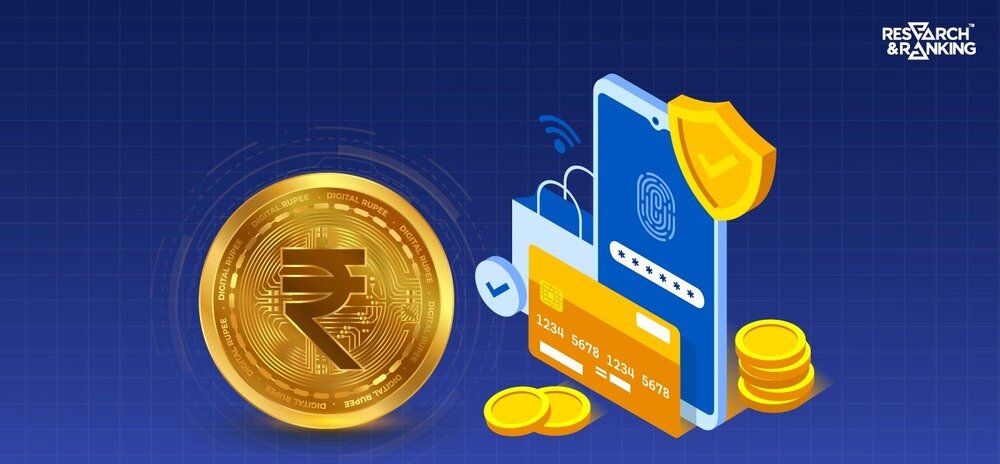Have you heard of the digital rupee? It’s a new kind of money that the Reserve Bank of India (RBI) is testing out. It’s not like the paper notes and coins that we use every day. It’s also not like the cryptocurrencies you may have heard of, like Bitcoin or Ethereum. It’s a currency of its own kind.
What is Digital Rupee?
The digital rupee is the Indian rupee that went digital. It’s like having money in your phone or device instead of your wallet or bank account. You can use it to buy things and pay for services, just like you do with cash or cards. You can also send it to anyone, anywhere, anytime, without any hassle or fees. It quite literally works in the form of exchanging notes like we are used to doing, but instead of notes being made of paper, they are completely digital.
Types of Digital Rupee
The digital rupee has two forms: one for big transactions, like interbank settlements, and one for small transactions, like consumer and business payments. The one for small transactions is called the retail digital rupee (e₹-R), and that’s the one we are going to focus on, as that concerns us, the layman.
How does the Retail Digital Rupee (e₹-R) work?
The e₹-R can be accessed through a digital wallet offered by participating banks. You can store it on your phone or other smart device and use it to make payments through person-to-person (P2P) or person-to-merchant (P2M) modes, using QR codes or other methods. The e₹-R does not make any interest and can be converted to other forms of money, such as bank deposits. In a nutshell, we are replacing our physical tokens with digital versions of the same, which saves a lot of money and resources on printing, distributing, and managing physical currency, which costs ₹49,84 Crores.
Inclusion of all economic classes
Despite so much digital advancement, 89 percent of transactions in India are made through cash. It’s not because people are apprehensive of digital methods of transaction. They are unable to access these methods for various reasons:
- A 10th of India’s population lives below the poverty line, and earning daily wages is a challenge, so maintaining a bank account becomes pretty much impossible.
- About 190 Million Indians don’t have access to a bank account, and one of the most common reasons for this is that the majority of India stays in rural areas, and access to banks is scarce for them.
- Elderly people have a hard time coping with digital advancements in transactions and hence prefer to stick to the old method of exchanging notes.
Bridging the gap
As India grows and digitally progresses, this section of the population is being left behind as it lacks the access to the digital world due to their limited their ability to make transactions, the digital rupee fixes that, here are some examples:
- With advancements in technology, education has become cheaper, but only for people who can pay the fee of the digital educational platform, and the digital rupee enables a person with a lack of bank account to just pay with their tokens online and access it.
- A new start-up in India makes high-quality goods cheaper and more accessible to the people of India. Still, due to the nature of their business, they only accept advance payment through online mediums. Now, people who don’t have a bank account can still access these options.
- As the payment method becomes traceable, the unfair pay of wages to workers can be addressed because the authorities can see if a person is being paid below the minimum wage mark.
These were just a few examples. The digital rupee can help a huge segment of India to reach better heights.
Challenges RBI May Face
The ambitious and innovative project is a step towards realizing the vision of a ‘less cash and more digital India,’ where everyone can access and benefit from the digital payment ecosystem. However, RBI is up for a challenge to fit the digital currency in the current landscape:
- Requires a clear and comprehensive legal and regulatory framework to define its status, scope, and functions. And will have to comply with the existing laws and regulations.
- Needs a robust and secure technological design and architecture to ensure its functionality, interoperability, scalability, cyber security, data protection, and system resilience.
- Must gain the trust and confidence of consumers and businesses, who may be unfamiliar or reluctant to use a new form of money.
- May affect the money supply, interest rates, inflation, exchange rates, and credit creation, and thus the country’s monetary policy and financial stability.
The RBI understands these concerns, and that is why the currency is still being tested, while feedback and suggestions from the public and stakeholders are welcomed.
How useful was this post?
Click on a star to rate it!
Average rating 5 / 5. Vote count: 3
No votes so far! Be the first to rate this post.
I’m Archana R. Chettiar, an experienced content creator with
an affinity for writing on personal finance and other financial content. I
love to write on equity investing, retirement, managing money, and more.
-
Archana Chettiarhttps://www.equentis.com/blog/author/archana/
-
Archana Chettiarhttps://www.equentis.com/blog/author/archana/
-
Archana Chettiarhttps://www.equentis.com/blog/author/archana/
-
Archana Chettiarhttps://www.equentis.com/blog/author/archana/

